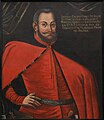Hetman
Hetman is a political title from
Etymology
The term hetman was a Polish borrowing, most likely stemming via Czech from the Turkic title ataman (literally 'father of horsemen'),[1][2] however it could also come from the German Hauptmann – captain.[3] Since hetman as a title first appeared in Czechia in the 15th century, assuming it stems from a Turkic language, it is possible it was introduced to Czechs by the Cumans.
Hetmans of Poland and Lithuania
The Polish title Grand Crown Hetman (
From 1585, the title could not be taken away without a proven charge of treachery, thus most hetmans served for life, as illustrated by the case of
This system worked well when a hetman had great ability and the monarch was weak, but sometimes produced disastrous results in the opposite case. The security of the position notably contrasted with that of military leaders in states bordering the commonwealth, where sovereigns could dismiss their army commanders at any time. In 1648 the Zaporizhian Host (the Polish–Lithuanian Commonwealth subject) elected a hetman of their own, Bohdan Khmelnytsky, igniting the Ukrainian struggle for independence.
The military reform of 1776 limited the powers of the hetmans. The Hetman office was abolished after the Third Partition of Poland (1795).
-
Hetman Mikołaj "the Red" Radziwiłł
-
Hetman Jan Karol Chodkiewicz wearing a traditional costume of Polish magnates
-
Janusz Radziwiłł, one of the most powerful people in the Commonwealth at the time
Hetmans of the Zaporozhian Host and Ukraine
| Part of a series on |
| Cossacks |
|---|
 |
| Cossack hosts |
| Other Cossack groups |
| History |
| Notable Cossacks |
| Cossack terms |

At the end of the sixteenth century, the commanders of the
After the split of
In the
The title was revived in Ukraine during the revolution of 1917 to 1920. In early 1918, a conservative German-supported
Hetmans of Bohemia, Romania, and Moldavia
Used by the Czechs in Bohemia from the Hussite Wars (15th century) onward, hejtman is today the term for the elected governor of a Czech region (kraj).
For much of the history of
Other uses
Hetman has often been used figuratively to mean 'commander' or simply 'leader'. Examples:
- "They say there was a whole band of them, and that this bearded man was their elder, the hetman." — Mother (1906)[4]
Queen (chess piece) is called hetman in Polish and coded as H in the algebraic notation.
See also
References
- ^ "The Cossacks: A super-ethnos in Russia's ribs". The Economist. December 21, 1996.
- ^ "Ataman". Cossackweb.narod.ru. Retrieved July 6, 2012.
- ISBN 9780199601080.
- ^ Gorky, Maxim (1906). Mother. New York/London: D. Appleton–Century Company. p. 372 – via Internet Archive.
They say there was a whole band of them, and that this bearded man was their elder, the hetman.
External links
 Media related to Hetmans at Wikimedia Commons
Media related to Hetmans at Wikimedia Commons- . Encyclopædia Britannica. Vol. 13 (11th ed.). 1911.



